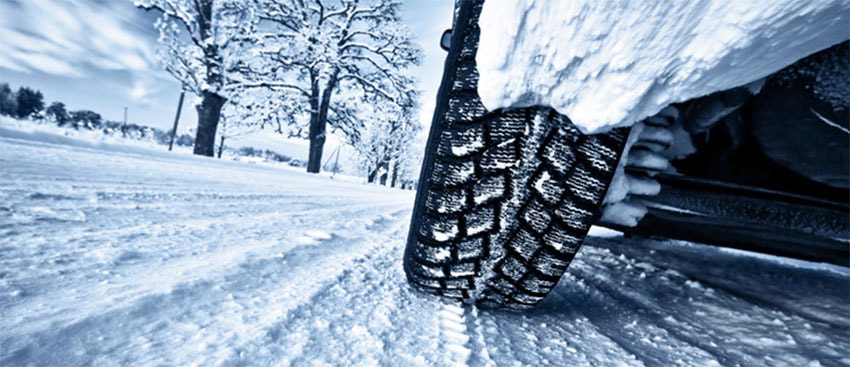Winter Stopping Components
Looking for winter driving safety tips? This page explains the role of traction control, shock absorbers, anti-lock brakes, and maintenance for better winter driving.
As a city in southern Alberta – a region known for its snowstorms and winter cold – there’s bound to be days in Calgary where you find yourself on a snow-covered Deerfoot Trail or a dark and icy 16 Ave at rush hour. However, modern vehicles have all kinds of winter driving equipment and safety systems built in to help you keep control on slick surfaces. If you keep them well maintained and ready, you can help keep yourself safe, no matter the winter driving conditions. Traction Control
One of these helpful systems is traction control, which is a real-time analysis of how your wheels are moving and whether they are getting any traction on road surfaces. The computers in your vehicle send power back and forth from one wheel to another to try and maximize friction and grip along the road surface, reducing your chances of skidding out into the ditch or the shoulder. Your heads-up display (HUD) on the dashboard should have lights or other indicators to show that the system is working when your wheels are spinning on gravel, ice, or dirt. If not, then you know there’s an issue somewhere along the line.
Shock Absorbers
Shock absorbers allow your tires to keep better contact with the ground while driving through rough or bumpy terrain, by automatically adjusting to the changing surface. However, like all good things, they don’t last forever, and when they start to wear away, your driving experience can be significantly lessened: not only will your ride be bumpier and rougher, but factors like your stopping distance will be increased as well. On smooth pavement this may not feel like much, but on gravel or less maintained roads – like many of the secondary highways around Rocky View, Foothills, and Wheatland counties, crossing the landscape between Calgary, Lethbridge, and Medicine Hat – it can make a huge difference.
Because bad shocks are less effective at keeping your tires down on the road surface, during a hard brake the rubber is likely to actually lift up off of it as the weight and momentum of the car builds up and releases again and again. From there, it’s simple math – less contact with the road, more time to stop. In fact, depending on speed, it can take an additional 15-20 feet to stop if your shocks are worn down, and in a potential crash situation, that can be the difference between a near miss and a deadly accident. If you do any driving in the Kananaskis area, with its large wildlife population, good shock absorbers can help prevent collisions with deer, moose, or other animals that may suddenly run into your path. How to tell if your shock absorbers need replacing.
Here’s how you can tell if your shocks are wearing out, making them unsafe for winter driving in Canada and our notoriously heavy snowstorms. Some of the most common warning signs are:
Anti-lock Braking Systems (ABS)
Anti-lock braking systems operate by preventing your wheels from locking up and skidding along a surface when the brake pedal is held. This allows for improved steering in a skid and less wear on the friction points. In these systems, the computers track wheel speed, hydraulic pressure, air pressure, and other factors, and if they cross certain thresholds in combination – like when the hydraulic pressure increases while going highway speed – then the ABS system kicks in. It will input and remove pressure from the system, increasing and decreasing the braking ability, to allow for maximum control at the most efficient stopping speed.
On freeways prone to icing over at spots, like the bridges of Stoney Trail, ABS is a big boost to your control in winter driving conditions. However, situations that call for the system to be engaged are, by nature, hard on your brakes. It’s not a bad idea to get them checked out by a pro if you’ve had to aggressively slam on your brakes recently. Maintenance for Winter Driving Equipment.
There’s no doubt that these systems are great, and that their implementation has revolutionized the safety of the vehicles they are in. But they are all dependent on proper maintenance in order to function, and require systematic checks to make sure they are operating at their best potential. Don’t wait until the snow falls again or an accident almost takes you out before you think about what’s going on in your engine and throughout your vehicle. Be proactive, get everything looked at, and save yourself trouble and worry by knowing that you’re doing all you can in order to be safe on the road.
At West Tech Mobile, we are certified to inspect winter driving equipment and many other components, and our knowledgeable technicians can make sure you’re roadworthy, even on days without warm chinook weather. With our fleet of service vehicles, we can even come to you for an added layer of convenience. Contact us today to find out more, and stay safe out there. Comments are closed.
|
|
What Sets Us Apart
• Service Trucks & Mobile Service • 5 Laptops & 1 North American automotive scanner • Commercial Vehicle Inspection Programs • Fleet Maintenance • Trailer Shuttles • Open 6 days a week |


 RSS Feed
RSS Feed
